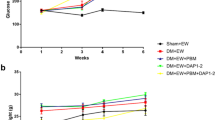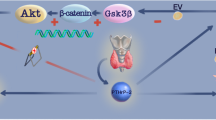Abstract
Objective
To evaluate the effect of phage-displayed TGF-β1 model peptide on cutaneous wound healing in streptozotocin-induced diabetic rats.
Methods
Full-thickness excisional wounds were made on the dorsums of 50 rats which were then randomly divided into five groups: negative control group (normal saline (NS)), two TGF-β1 control groups which were respectively treated with low-dose TGF-β1 ( 5 ng/ml) and high-dose TGF-β1 (50 ng/ml), and two model-peptide-treated groups which were respectively treated with low-dose model peptide ( 5 ng/ml,) and high-dose model peptide (50 ng/ml). At day 14 post-injury, rats were euthanised and wounds were assessed by gross, histopathology, immunohistochemistry, immunofluorescence and quantificational real-time polymerase chain reaction.
Results
A significant increase in rate of wound closure was observed in model peptide groups in comparison to negative control group. The results of histopathological staining revealed that re-epithelization and collagen deposition in model-peptide-treated groups were significantly higher than those in negative control group. The results of immunohistochemistry and immunofluorescence tests showed that Ki67-positive, VEGFA-positive, CD31-positive, α-SMA-positive, CD206-positive cells in model peptide and TGF-β1 control groups were more than those in negative control group. Furthermore, comparing with the mRNA expression profile in negative control groups, mRNA expression profile in model peptide group showed a decrease in proinflammatory cytokine and an increase in anti-inflammatory cytokine and collagen.
Conclusions
Phage-displayed TGF-β1 peptide facilitates wound healing through accelerating re-epithelialization, enhancing collagen deposition, promoting neo-vascularization, and inhibiting inflammatory response. Model peptide possesses the potential to be a promising treatment strategy for enhancing diabetic wound repair.






















Similar content being viewed by others
References
Barrientos S, Brem H, Stojadinovic O, Tomic-Canic M (2014) Clinical application of growth factors and cytokines in wound healing. Wound Repair Regen 22:569–578
Cai W, Salvador-Reyes LA, Zhang W, Chen QY, Matthew S, Ratnayake R et al (2018) Apratyramide, a of VEGF-A and other growth factors with Potential application in wound healing marine-derived peptidic stimulator . ACS Chem Biol 13:91–99
Cho NH, Shaw JE, Karuranga S, Huang Y, Da RFJ, Ohlrogge AW et al (2018) IDF Diabetes Atlas: global estimates of diabetes prevalence for 2017 and projections for 2045. Diabetes Res Clin Pract 138:271–281
Crider BJ, Risinger GJ, Haaksma CJ, Howard EW, Tomasek JJ (2011) Myocardin-related transcription factors A and B are key regulators of TGF-β1-induced fibroblast to myofibroblast differentiation. J Invest Dermatol 131:2378–2385
Deyle K, Kong XD, Heinis C (2017) Phage selection of cyclic peptides for application in research and drug development. Acc Chem Res 50:1866–1874
Gamble JR, Vadas MA (1988) Endothelial adhesiveness for blood neutrophils is inhibited by transforming growth factor-beta. Science 242:97–99
Goumans MJ, Liu Z, Ten DP (2009) TGF-beta signaling in vascular biology and dysfunction. Cell Res 19:116–127
Gu Y, Feng Y (2018) Down-regulation of TGF-β RII expression is correlated with tumor growth and invasion in non-functioning pituitary adenomas. J Clin Neurosci 47:264–268
Hou J, Chen L, Liu Z, Li J, Yang J, Zhong A et al (2019) Sustained release of N-acetylcysteine by sandwich structured polycaprolactone/collagen scaffolds for wound healing. J Biomed Mater Res A 107:1414–1424
Howangyin KY, Silvestre JS (2014) Diabetes mellitus and ischemic diseases: molecular mechanisms of vascular repair dysfunction. Arterioscler Thromb Vasc Biol 34:1126–1135
Kallmyer NE, Rider NE, Reuel NF (2020) Design and validation of a frugal, automated, solid-phase peptide synthesizer. PLoS ONE 15:e0237473
Kim KK, Sheppard D, Chapman HA (2018) TGF-β1 Signaling and Tissue fibrosis. Cold Spring Harb Perspect Biol 10:e000293
Li J, Chou H, Li L, Li H, Cui Z (2020) Wound healing activity of neferine in experimental diabetic rats through the inhibition of inflammatory cytokines and nrf-2 pathway. Artif Cells Nanomed Biotechnol 48:96–106
Lichtman MK, Otero-Vinas M, Falanga V (2016) Transforming growth factor beta (TGF-β) isoforms in wound healing and fibrosis. Wound Repair Regen 24:215–222
Lipok M, Szlachcic A, Kindela K, Czyrek A, Otlewski J (2019) Identification of a peptide antagonist of the FGF1-FGFR1 signaling axis by phage display selection. FEBS Open Biol 9:914–924
Liu R, Li X, Xiao W, Lam KS (2017) Tumor-targeting peptides from combinatorial libraries. Adv Drug Deliv Rev 110–111:13–37
Meyer M (2019) Processing of collagen based biomaterials and the resulting materials properties. Biomed Eng Online 18:24
Mirastschijski U, Schnabel R, Claes J, Schneider W, Agren MS, Haaksma C et al (2010) Matrix metalloproteinase inhibition delays wound healing and blocks the latent transforming growth factor-beta1-promoted myofibroblast formation and function. Wound Repair Regen 18:223–234
Okizaki S, Ito Y, Hosono K, Oba K, Ohkubo H, Amano H et al (2015) Suppressed recruitment of alternatively activated macrophages reduces TGF-β1 and impairs wound healing in streptozotocin-induced diabetic mice. Biomed Pharmacother 70:317–325
Okonkwo UA, DiPietro LA (2017) Diabetes and wound angiogenesis. Int J Mol Sci 18:1419
Patel S, Srivastava S, Singh MR, Singh D (2019) Mechanistic insight into diabetic wounds: pathogenesis, molecular targets and treatment strategies to pace wound healing. Biomed Pharmacother 112:108615
Qiang X, Sun K, Xing L, Xu Y, Wang H, Zhou Z et al (2017) Discovery of a polystyrene binding peptide isolated from phage display library and its application in peptide immobilization. Sci Rep 7:2673
Ranges GE, Figari IS, Espevik T, Palladino MJ (1987) Inhibition of cytotoxic T cell development by transforming growth factor beta and reversal by recombinant tumor necrosis factor alpha. J Exp Med 166:991–998
Ren J, Yang M, Xu F, Chen J, Ma S (2019) Acceleration of wound healing activity with syringic acid in streptozotocin induced diabetic rats. Life Sci 233:116728
Saw PE, Song EW (2019) Phage display screening of therapeutic peptide for cancer targeting and therapy. Protein Cell 10:787–807
Shiekh PA, Singh A, Kumar A (2020) Exosome laden oxygen releasing antioxidant and antibacterial cryogel wound dressing OxOBand alleviate diabetic and infectious wound healing. Biomaterials 249:120020
Shull MM, Ormsby I, Kier AB, Pawlowski S, Diebold RJ, Yin M et al (1992) Targeted disruption of the mouse transforming growth factor-beta 1 gene results in multifocal inflammatory disease. Nature 359:693–699
Smith GP (1985) Filamentous fusion phage: novel expression vectors that display cloned antigens on the virion surface. Science 228:1315–1317
Tsunawaki S, Sporn M, Ding A, Nathan C (1988) Deactivation of macrophages by transforming growth factor-beta. Nature 334:260–262
Vander AA, Cao J, Li X (2018) TGF-β receptors: In and beyond TGF-β signaling. Cell Signal 52:112–120
Wahl SM (1992) Transforming growth factor beta (TGF-beta) in inflammation: a cause and a cure. J Clin Immunol 12:61–74
Wang X, Ma W, Han S, Meng Z, Zhao L, Yin Y et al (2017) TGF-β participates choroid neovascularization through Smad2/3-VEGF/TNF-α signaling in mice with Laser-induced wet age-related macular degeneration. Sci Rep 7:9672
Xu MT, Sun S, Zhang L, Xu F, Du SL, Zhang XD et al (2016) Diabetes mellitus affects the biomechanical function of the callus and the expression of TGF-beta1 and BMP2 in an early stage of fracture healing. Braz J Med Biol Res 49:e4736
Yun S, Lee S, Park JP, Choo J, Lee EK (2019) Modification of phage display technique for improved screening of high-affinity binding peptides. J Biotechnol 289:88–92
Zhao Y, Wang Q, Hong A, Chen X (2019) Screening and identification of small peptides targeting fibroblast growth factor receptor2 using a phage display peptide library. J Vis Exp 151:e60189
Zong X, Yu P, Lu H, Pan B, Song G, Lai C et al (2019) Phage display, peptide production and biological assessment of key sequence of TGF-β1. Int J Pept Res Ther 25:1217–1223
Zong X, Yu P, Lu H, Pan B, Song G, Lai C et al (2020) Correction to: phage display, peptide production and biological assessment of key sequence of TGF-β1. Int J Pept Res Ther 25(3):1217–1223. https://doi.org/10.1007/s10989-018-9774-x)
Acknowledgements
This study was supported by the National Natural Science Foundation of China (30670571, 81201467), and the Scientific Research Fund for Youth of Chinese Academy of Medical Sciences and Peking Union Medical College (2017310007). Otherwise, all the authors declare that they have no financial or personal interference with other people or organizations that could inappropriately influence their work.
Funding
This study was supported by the National Natural Science Foundation of China (30670571, 81201467), and the Scientific Research Fund for Youth of Chinese Academy of Medical Sciences and Peking Union Medical College (2017310007).
Author information
Authors and Affiliations
Corresponding authors
Ethics declarations
Conflict of Interest
The authors declare that there are no conflicts of interest.
Ethics Approval
The current research was approved by the Medical Ethical Committee at Plastic Surgery Hospital of Peking Union Medical College, Chinese Academy of Medical Sciences, Beijing, China.
Research Involving Human and Animal Participants
50 female Sprague–Dawley (SD) rats were obtained from Beijing Medical Laboratory Animal Center (SYXK 2020–0018). Fibroblasts were obtained from a healthy patient underwent abdominoplasty.
Informed Consent
Informed consent was given by the patient who donated skin for cell culture.
Additional information
Publisher's Note
Springer Nature remains neutral with regard to jurisdictional claims in published maps and institutional affiliations.
Rights and permissions
About this article
Cite this article
Du, H., Jiang, D., Song, G. et al. Wound Healing Activity of Phage-Sisplayed TGF-β1 Model Peptide in Streptozotocin-Induced Diabetic Rats. Int J Pept Res Ther 27, 1079–1094 (2021). https://doi.org/10.1007/s10989-020-10152-1
Accepted:
Published:
Issue Date:
DOI: https://doi.org/10.1007/s10989-020-10152-1




